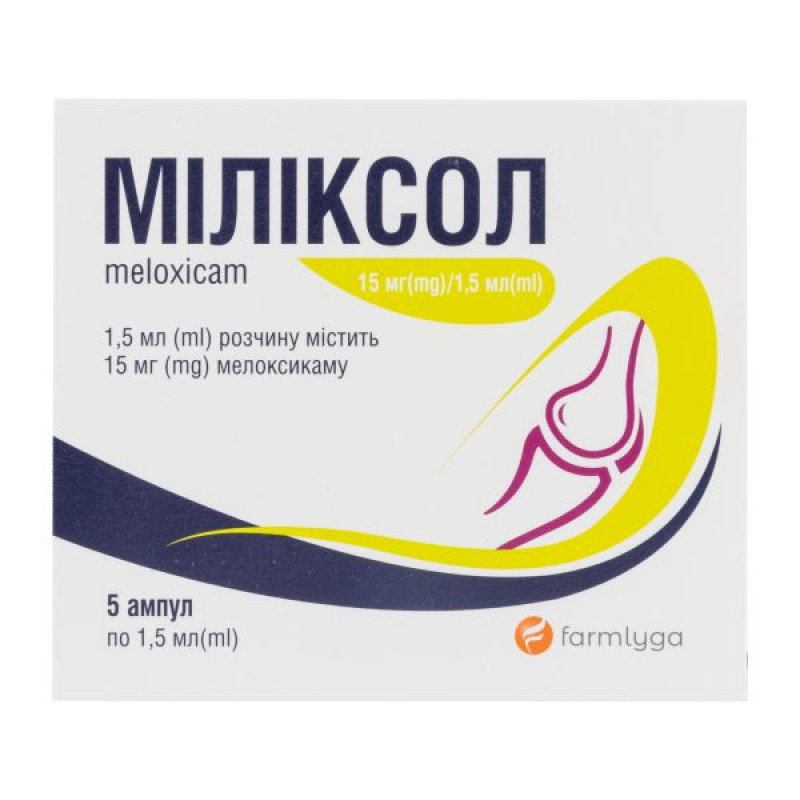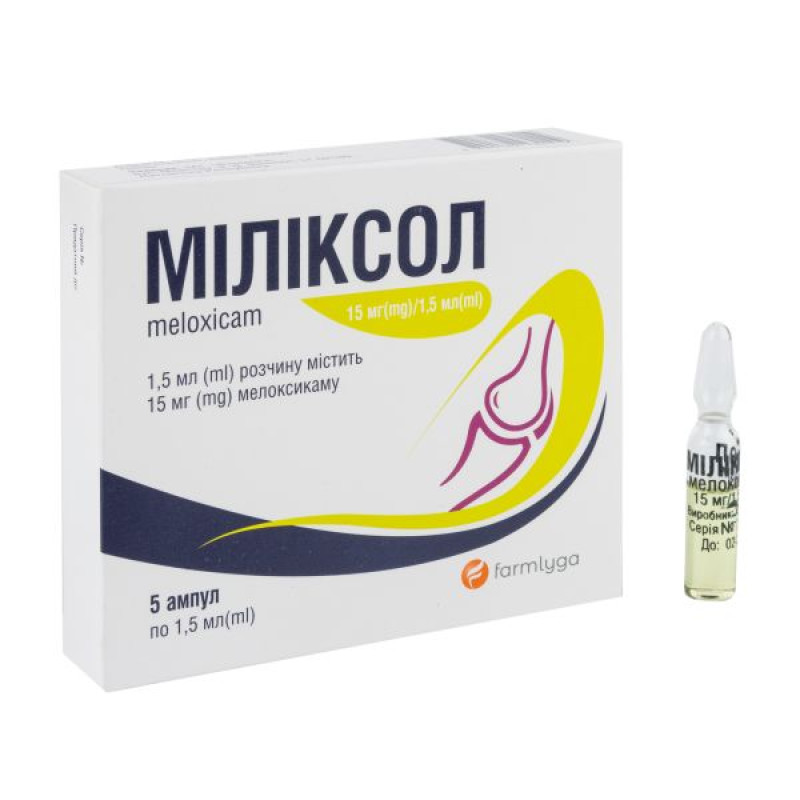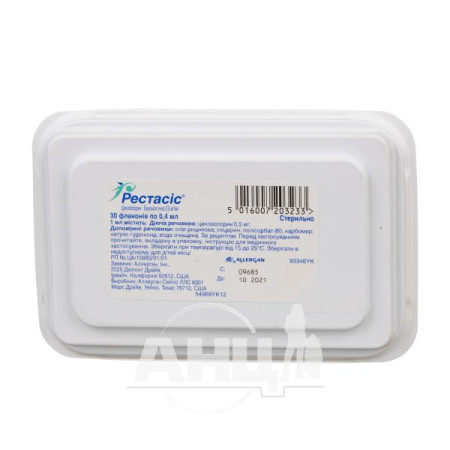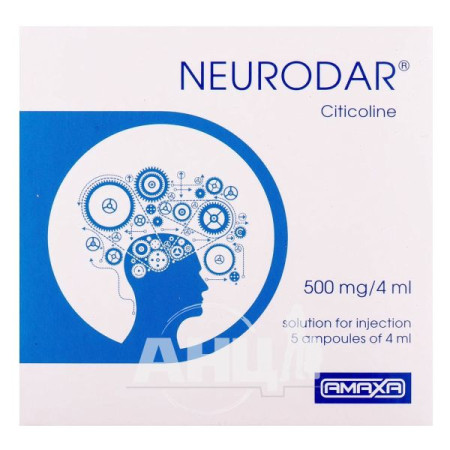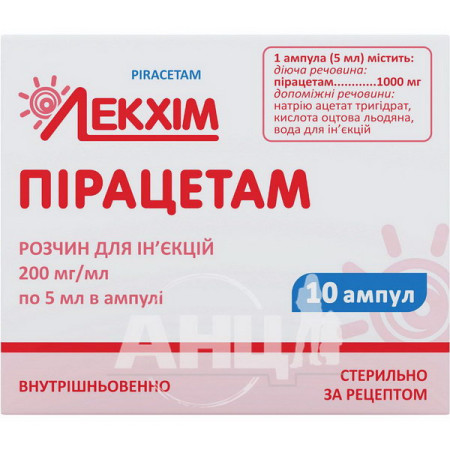Milixol solution for injection 15 mg/1.5 ml ampoule 1.5 ml No. 5
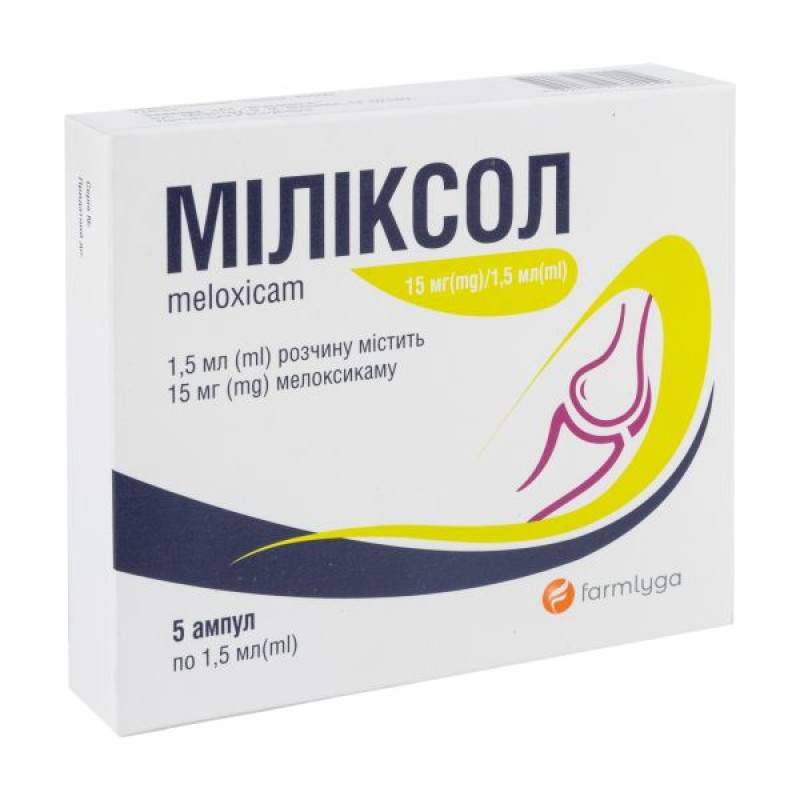
Instructions for Milixol solution for injection 15 mg/1.5 ml ampoule 1.5 ml No. 5
Composition
active ingredient: meloxicam;
1.5 ml of solution contains 15 mg of meloxicam;
excipients: meglumine, glycofurol, poloxamer 188, sodium chloride, glycine, sodium hydroxide, water for injections.
Dosage form
Solution for injection.
Main physicochemical properties: transparent solution of yellow with a green tint, practically free from visible particles.
Pharmacotherapeutic group
Nonsteroidal anti-inflammatory and antirheumatic drugs. ATC code M01A C06.
Pharmacological properties
Pharmacodynamics
Milixol is a nonsteroidal anti-inflammatory drug (NSAID) of the enoleic acid class that has anti-inflammatory, analgesic, and antipyretic effects.
Meloxicam has shown high anti-inflammatory activity in all standard models of inflammation. As with other NSAIDs, its exact mechanism of action remains unknown. However, there is a common mechanism of action for all NSAIDs (including meloxicam): inhibition of the biosynthesis of prostaglandins, which are mediators of inflammation.
Pharmacokinetics
Absorption. Meloxicam is completely absorbed after intramuscular injection. The relative bioavailability compared to oral administration is almost 100%. Therefore, dose adjustment is not required when switching from intramuscular to oral administration. After an intramuscular injection of 15 mg, the maximum plasma concentration is about 1.6-1.8 μg/ml and is reached in 1-6 hours.
Distribution. Meloxicam is highly bound to plasma proteins, mainly albumin (99%). Meloxicam penetrates into the synovial fluid, where its concentration is half that in blood plasma. The volume of distribution is low, averaging 11 l after intramuscular or intravenous administration, and shows individual variations in the range of 7-20%. The volume of distribution after multiple oral doses of meloxicam (7.5 to 15 mg) is 16 l with a coefficient of variation in the range of 11 to 32%.
Biotransformation: Meloxicam undergoes extensive biotransformation in the liver.
Four different metabolites of meloxicam have been identified in urine, which are pharmacodynamically inactive. The main metabolite, 5'-carboxymeloxicam (60% of the dose), is formed by oxidation of an intermediate metabolite, 5'-hydroxymethylmeloxicam, which is also excreted to a lesser extent (9% of the dose). In vitro studies suggest that CYP 2C9 plays an important role in the metabolism process, while CYP 3A4 isoenzymes play a minor role. Peroxidase activity in patients is probably responsible for the other two metabolites, which account for 16% and 4% of the administered dose, respectively.
Elimination. Meloxicam is excreted mainly as metabolites in equal parts with urine and feces. Less than 5% of the daily dose is excreted unchanged in the feces, a small amount is excreted in the urine. The half-life is 13-25 hours depending on the route of administration (oral, intramuscular or intravenous). Plasma clearance is about 7-12 ml/min after a single oral dose, intravenous or rectal administration.
Dose linearity: Meloxicam exhibits linear pharmacokinetics within the therapeutic dose range of 7.5 mg to 15 mg after oral and intramuscular administration.
Special groups of patients.
Patients with hepatic/renal insufficiency. Mild to moderate hepatic and renal insufficiency do not significantly affect the pharmacokinetics of meloxicam. Patients with moderate renal insufficiency had a significantly higher total clearance. Reduced binding to plasma proteins was observed in patients with end-stage renal failure. In end-stage renal failure, an increase in the volume of distribution may lead to an increase in the concentration of free meloxicam. The daily dose of 7.5 mg should not be exceeded (see section "Method of administration and dosage").
Elderly patients. In elderly male patients, mean pharmacokinetic parameters were similar to those in young male volunteers. In elderly female patients, AUC values were higher and the half-life was longer compared to those in young volunteers of both sexes. Mean steady-state plasma clearance in elderly patients was slightly lower than in young volunteers.
Indication
Short-term symptomatic treatment of acute attacks of rheumatoid arthritis and ankylosing spondylitis when oral and rectal routes of administration cannot be used.
Contraindication
III trimester of pregnancy (see section "Use during pregnancy or breastfeeding"); patient age up to 18 years; hypersensitivity to meloxicam or to other components of the drug, or to active substances with a similar effect, such as NSAIDs, aspirin. Meloxicam should not be prescribed to patients who have developed symptoms of asthma, nasal polyps, angioedema or urticaria after taking aspirin or other NSAIDs; gastrointestinal bleeding or perforation associated with previous NSAID therapy in history; active or recurrent peptic ulcer/bleeding in history (two or more separate confirmed cases of ulceration or bleeding); severe hepatic failure; severe renal failure, without dialysis; gastrointestinal bleeding, cerebrovascular bleeding in history or other blood clotting disorders; hemostasis disorders or concomitant use of anticoagulants (contraindications related to the route of administration); severe heart failure; treatment of perioperative pain in coronary artery bypass grafting.
Interaction with other medicinal products and other types of interactions
Interaction studies have only been conducted with adults.
Risks associated with hyperkalemia.
Some medicinal products or therapeutic groups may contribute to hyperkalaemia: potassium salts, potassium-sparing diuretics, angiotensin-converting enzyme (ACE) inhibitors, angiotensin II receptor antagonists, non-steroidal anti-inflammatory drugs, (low molecular weight or unfractionated) heparins, ciclosporin, tacrolimus and trimethoprim.
The onset of hyperkalemia may depend on whether there are associated factors. The risk of hyperkalemia is increased if the above-mentioned drugs are used concomitantly with meloxicam.
Pharmacodynamic interactions
Other non-steroidal anti-inflammatory drugs (NSAIDs) and acetylsalicylic acid ≥ 3 g/day. Combination with other NSAIDs (see section "Special warnings and precautions for use"), acetylsalicylic acid in doses ≥ 500 mg per dose or ≥ 3 g total daily dose is not recommended.
Corticosteroids (e.g. glucocorticoids): Concomitant use with corticosteroids requires caution due to increased risk of gastrointestinal bleeding or ulceration.
Anticoagulants or heparin used in geriatric practice or at therapeutic doses. The risk of bleeding is significantly increased due to inhibition of platelet function and damage to the gastroduodenal mucosa. NSAIDs may enhance the effects of anticoagulants such as warfarin (see section "Special instructions"). The concomitant use of NSAIDs and anticoagulants or heparin in geriatric practice or at therapeutic doses is not recommended (see section "Special instructions"). Due to the intramuscular administration, meloxicam solution for injection is contraindicated in patients receiving anticoagulant treatment (see sections "Contraindications" and "Special instructions").
In other cases (for example, at prophylactic doses), the use of heparin requires caution due to the increased risk of bleeding.
Thrombolytic and antiplatelet drugs. Increased risk of bleeding through inhibition of platelet function and damage to the gastroduodenal mucosa.
Selective serotonin reuptake inhibitors (SSRIs): Increased risk of gastrointestinal bleeding.
Diuretics, ACE inhibitors and angiotensin II antagonists. NSAIDs may reduce the effect of diuretics and other antihypertensive drugs. In some patients with impaired renal function (e.g. dehydrated patients or elderly patients with impaired renal function), the concomitant use of ACE inhibitors or angiotensin II antagonists and drugs that inhibit cyclooxygenase may lead to further deterioration of renal function, including possible acute renal failure, which is usually reversible. Therefore, the combination should be used with caution, especially in elderly patients. Patients should be adequately hydrated and renal function should be monitored after initiation of concomitant therapy and periodically thereafter (see section 4.4).
Other antihypertensive drugs (e.g. beta-blockers). As with the following drugs, the antihypertensive effect of beta-blockers may be reduced (due to inhibition of vasodilating prostaglandins).
Calcineurin inhibitors (e.g. cyclosporine, tacrolimus). The nephrotoxicity of calcineurin inhibitors may be potentiated by NSAIDs through mediation of the effects of renal prostaglandins. Renal function should be monitored during treatment. Close monitoring of renal function is recommended, especially in elderly patients.
Intrauterine contraceptives. NSAIDs reduce the effectiveness of intrauterine contraceptives. It has been previously reported that the effectiveness of intrauterine contraceptives is reduced by NSAIDs, but this requires further confirmation.
Deferasirox.
Concomitant use of meloxicam and deferasirox may increase the risk of gastrointestinal adverse reactions. Caution should be exercised when combining these drugs.
Pharmacokinetic interactions
Lithium. There is evidence that NSAIDs increase the level of lithium in the blood plasma (by reducing the renal excretion of lithium), which can reach toxic levels. The simultaneous use of lithium and NSAIDs is not recommended (see section "Special instructions"). If combination therapy is necessary, careful monitoring of lithium plasma levels is necessary at the beginning of treatment, during dose adjustment and when discontinuing treatment with meloxicam.
Methotrexate. NSAIDs may reduce the tubular secretion of methotrexate, thereby increasing its plasma concentration. For this reason, concomitant use of NSAIDs is not recommended in patients receiving high doses of methotrexate (more than 15 mg/week) (see section "Special warnings and precautions for use"). The risk of interaction between NSAIDs and methotrexate should also be considered in patients receiving low doses of methotrexate, including patients with impaired renal function. If combined treatment is necessary, blood counts and renal function should be monitored. Caution should be exercised when NSAIDs and methotrexate are taken for 3 consecutive days, as plasma levels of methotrexate may increase and toxicity may increase. Although the pharmacokinetics of methotrexate (15 mg/week) were not affected by concomitant treatment with meloxicam, it should be considered that the hematological toxicity of methotrexate may be increased by treatment with NSAIDs (see above) (see section "Adverse reactions").
Pemetrexed. When meloxicam is used concomitantly with pemetrexed in patients with mild to moderate renal impairment (creatinine clearance 45 to 79 ml/min), meloxicam should be discontinued 5 days before, on the day of, and for 2 days after pemetrexed administration. If the combination of meloxicam and pemetrexed is necessary, patients should be closely monitored, particularly for myelosuppression and gastrointestinal adverse reactions. In patients with severe renal impairment (creatinine clearance below 45 ml/min), the concomitant use of meloxicam and pemetrexed is not recommended.
In patients with normal renal function (creatinine clearance ≥ 80 ml/min), doses of 15 mg meloxicam may reduce the elimination of pemetrexed and, therefore, increase the incidence of adverse reactions associated with pemetrexed. Therefore, caution should be exercised when prescribing 15 mg meloxicam concomitantly with pemetrexed in patients with normal renal function (creatinine clearance ≥ 80 ml/min).
The effect of other drugs on the pharmacokinetics of meloxicam.
Cholestyramine accelerates the elimination of meloxicam by disrupting intrahepatic circulation, so the clearance of meloxicam increases by 50% and the half-life decreases to 13±3 hours. This interaction is clinically significant.
No clinically significant pharmacokinetic interaction was found when co-administered with antacids, cimetidine, and digoxin.
Application features
Adverse reactions can be minimised by using the lowest effective dose for the shortest duration necessary to control symptoms (see section “Dosage and Administration” and information on gastrointestinal and cardiovascular risks below).
The recommended maximum daily dose should not be exceeded in case of insufficient therapeutic effect, nor should additional NSAIDs be used, as this may increase toxicity while the therapeutic benefit has not been proven. The concomitant use of meloxicam with NSAIDs, including selective cyclooxygenase-2 inhibitors, should be avoided.
Meloxicam should not be used to relieve acute pain.
If there is no improvement after several days, the clinical benefit of treatment should be reassessed.
Attention should be paid to a history of esophagitis, gastritis and/or peptic ulcer in order to ensure that they are completely cured before starting therapy with meloxicam. Patients treated with meloxicam and patients with a history of such cases should be regularly monitored for possible recurrence.
Gastrointestinal disorders.
As with other NSAIDs, potentially fatal gastrointestinal bleeding, ulceration or perforation may occur at any time during treatment with or without previous symptoms or a history of serious gastrointestinal disease.
The risk of gastrointestinal bleeding, ulceration or perforation is higher with increasing NSAID doses in patients with a history of ulcer, particularly complicated by bleeding or perforation (see section 4.3), and in the elderly. In such patients, treatment should be initiated at the lowest effective dose. Combination therapy with protective agents (such as misoprostol or proton pump inhibitors) should be considered for such patients, as well as for patients who require concomitant use of low-dose aspirin or other agents that increase gastrointestinal risks (see information below and section 4.5).
The use of meloxicam is not recommended in patients taking concomitant medications that may increase the risk of ulceration or bleeding, such as heparin, as a radical therapy or in geriatric practice, anticoagulants such as warfarin or other non-steroidal anti-inflammatory drugs, or acetylsalicylic acid (doses ≥ 500 mg per dose or ≥ 3 g total daily dose) (see section "Interaction with other medicinal products and other forms of interaction").
If gastrointestinal bleeding or ulceration occurs in patients taking meloxicam, treatment should be discontinued.
NSAIDs should be used with caution in patients with a history of gastrointestinal diseases (ulcerative colitis, Crohn's disease), as these conditions may be exacerbated (see section "Adverse reactions").
Liver disorders.
Up to 15% of patients taking NSAIDs (including Milixol) may have elevated values of one or more liver tests. Such laboratory abnormalities may progress, may remain unchanged, or may be transient with continued treatment. Significant increases in ALT or AST (approximately three times or more above normal) have been observed in 1% of patients during clinical trials with NSAIDs. In addition, rare cases of severe hepatic reactions, including jaundice and fulminant fatal hepatitis, hepatic necrosis, and hepatic failure, some of them fatal, have been reported during clinical trials with NSAIDs.
Patients with symptoms and/or signs of hepatic dysfunction or those with abnormal liver function tests should be evaluated for the development of more severe hepatic impairment during treatment with Milixol. If clinical signs and symptoms consistent with liver disease develop or if systemic manifestations of the disease occur (e.g. eosinophilia, rash, etc.), Milixol should be discontinued.
Cardiovascular disorders.
Close monitoring is recommended in patients with hypertension and/or a history of mild to moderate congestive heart failure, as fluid retention and edema have been reported with NSAID therapy.
Clinical monitoring of blood pressure is recommended in patients with risk factors at the beginning of therapy, especially at the beginning of treatment with meloxicam.
Clinical and epidemiological data suggest that the use of some NSAIDs (especially at high doses and in long-term treatment) may be associated with a small increased risk of vascular thrombotic events (such as myocardial infarction or stroke). There are insufficient data to exclude such a risk for meloxicam.
Patients with uncontrolled hypertension, congestive heart failure, established ischemic heart disease, peripheral arterial disease and/or cerebrovascular disease should be treated with meloxicam only after careful evaluation. Such evaluation is necessary before initiating long-term treatment in patients with risk factors for cardiovascular disease (e.g. hypertension, hyperlipidemia, diabetes mellitus, smoking).
NSAIDs may increase the risk of serious cardiovascular thrombotic events, myocardial infarction and stroke, which may be fatal. The increased risk is related to the duration of use. Patients with cardiovascular disease or risk factors for cardiovascular disease may be at increased risk of thrombotic events.
Skin disorders.
Life-threatening severe skin reactions: Stevens-Johnson syndrome and toxic epidermal necrolysis have been reported with meloxicam. Patients should be informed of the signs and symptoms of severe skin reactions and should be closely monitored for skin reactions. The greatest risk of developing Stevens-Johnson syndrome or toxic epidermal necrolysis is during the first weeks of treatment. If a patient develops symptoms or signs of Stevens-Johnson syndrome or toxic epidermal necrolysis (e.g. skin rash, often progressing with blisters or mucosal lesions), meloxicam treatment should be discontinued. It is important to promptly diagnose and discontinue any drugs that may cause severe skin reactions: Stevens-Johnson syndrome or toxic epidermal necrolysis. This is associated with a better prognosis in severe skin reactions. If a patient has developed Stevens-Johnson syndrome or toxic epidermal necrolysis while using meloxicam, the drug should not be restarted at any time in the future.
Anaphylactic reactions.
As with other NSAIDs, anaphylactic reactions may occur in patients with no known reaction to Milixol. Milixol should not be used in patients with the aspirin triad. This symptom complex occurs in patients with asthma who have reported rhinitis with or without nasal polyps or who have experienced severe, potentially fatal bronchospasm after taking aspirin or other NSAIDs. Emergency care should be sought if an anaphylactic reaction occurs.
As with most NSAIDs, isolated cases of increased serum transaminases, serum bilirubin or other liver function parameters, increased serum creatinine and blood urea nitrogen, and other laboratory abnormalities have been reported. In most cases, these abnormalities were minor and transient. If significant or persistent abnormalities occur, meloxicam should be discontinued and follow-up tests should be performed.
Functional renal failure.
NSAIDs, due to inhibition of the vasodilatory effect of renal prostaglandins, can induce functional renal failure by reducing glomerular filtration. This side effect is dose-dependent. At the beginning of treatment or after increasing the dose, careful monitoring of diuresis and renal function is recommended in patients with the following risk factors:
old age;
concomitant use with ACE inhibitors, angiotensin II antagonists, sartans, diuretics (see section "Interaction with other medicinal products and other types of interactions");
hypovolemia (of any origin); congestive heart failure; renal failure; nephrotic syndrome; lupus nephropathy; severe hepatic dysfunction (serum albumin < 25 g/l or ≥ 10 according to the Child-Pugh classification).
In rare cases, NSAIDs can lead to interstitial nephritis, glomerulonephritis, renal medullary necrosis, or nephrotic syndrome.
The dose of meloxicam for patients with end-stage renal disease on dialysis should not exceed 7.5 mg. In patients with mild to moderate renal impairment (creatinine clearance >25 ml/min), the dose may not be reduced.
Sodium, potassium and water retention.
NSAIDs may increase sodium, potassium and water retention and may interfere with the natriuretic effects of diuretics. In addition, the antihypertensive effect of antihypertensive drugs may be reduced (see section 4.5). As a result, edema, heart failure or hypertension may be precipitated or exacerbated in susceptible patients. Therefore, clinical monitoring is recommended in patients at risk of sodium, potassium and water retention (see sections 4.2 and 4.3).
Hyperkalemia.
Hyperkalemia may be caused by diabetes mellitus or concomitant use of medicinal products that increase potassium levels (see section 4.5). In such cases, potassium levels should be monitored regularly.
Other warnings and precautions.
Adverse reactions are often worse tolerated in elderly, frail or debilitated patients who require close monitoring. As with other NSAIDs, caution should be exercised in the elderly, who are more likely to have decreased renal, hepatic and cardiac function. Elderly patients have a higher incidence of adverse reactions to NSAIDs, especially gastrointestinal bleeding and perforation, which can be fatal (see section 4.2).
Meloxicam, like any other NSAID, may mask the symptoms of infectious diseases.
As with intramuscular administration of other NSAIDs, abscess or necrosis may occur at the injection site.
Meloxicam may impair reproductive function and is not recommended in women attempting to conceive. Therefore, in women attempting to conceive or undergoing investigation of infertility, discontinuation of meloxicam should be considered (see section 4.6).
This medicinal product contains less than 1 mmol sodium (23 mg) per 1.5 ml ampoule, i.e. essentially sodium-free.
Masking inflammation and fever.
The pharmacological action of Milixol, aimed at reducing fever and inflammation, may lead to false results when determining complications of a suspected non-infectious painful condition.
Corticosteroid treatment.
Milixol cannot be a likely substitute for corticosteroids in the treatment of corticosteroid insufficiency.
Hematological effects.
Anemia may occur in patients receiving NSAIDs, including Milixol. This may be due to fluid retention, gastrointestinal bleeding of unknown origin or macroscopic bleeding, or incompletely described effects on erythropoiesis. Patients on long-term treatment with NSAIDs, including Milixol, should have their hemoglobin or hematocrit monitored if they develop symptoms and signs of anemia.
NSAIDs inhibit platelet aggregation and may show prolongation of bleeding time in some patients. In contrast to aspirin, their effect on platelet function is quantitatively smaller, short-lived and reversible. Patients prescribed Milixol and who may have side effects related to changes in platelet function, such as blood clotting disorders, or patients receiving anticoagulants, require careful monitoring.
Patients with asthma may have aspirin-sensitive asthma. The use of aspirin in patients with aspirin-sensitive asthma has been associated with severe bronchospasm, which may be fatal. Due to cross-reactivity, including bronchospasm, between aspirin and other NSAIDs, Milixol should not be used in patients sensitive to aspirin and should be used with caution in patients with pre-existing asthma.
Combination with pemetrexed.
In patients with mild to moderate renal impairment receiving pemetrexed, meloxicam treatment should be suspended for at least 5 days prior to, on the day of, and for at least 2 days following pemetrexed administration (see section 4.5).
Ability to influence reaction speed when driving vehicles or other mechanisms
There are no specific studies on the effects of the drug on the ability to drive or use machines. However, based on the pharmacodynamic profile and the observed adverse reactions, meloxicam is likely to have no or negligible influence on these activities. However, patients who experience visual disturbances, including blurred vision, dizziness, drowsiness, vertigo or other central nervous system disorders, are advised to refrain from driving or using machines.
Use during pregnancy or breastfeeding
Fertility.
Meloxicam, like other drugs that inhibit cyclooxygenase/prostaglandin synthesis, may have an adverse effect on reproductive function and is not recommended in women attempting to conceive. Therefore, in women planning pregnancy or undergoing investigation of infertility, discontinuation of meloxicam should be considered.
Pregnancy.
Inhibition of prostaglandin synthesis may adversely affect pregnancy and/or embryonal/fetal development. Epidemiological data suggest an increased risk of miscarriage and of cardiac malformations and gastroschisis following the use of prostaglandin synthesis inhibitors in early pregnancy. The absolute risk of cardiac malformations has increased from less than 1% to approximately 1.5%. This risk is believed to increase with increasing dose and duration of treatment.
During the first and second trimesters of pregnancy, meloxicam should not be used unless clearly necessary. If meloxicam is used by a woman attempting to conceive or during the first and second trimesters of pregnancy, the dosage and duration of treatment should be kept to the minimum.
During the third trimester of pregnancy, all prostaglandin synthesis inhibitors may pose a risk to the fetus:
cardiopulmonary toxicity (with premature closure of the ductus arteriosus and pulmonary hypertension); renal dysfunction, which may progress to renal failure with oligohydramnios;
possible risks in the last stages of pregnancy for the mother and newborn:
possibility of prolongation of bleeding time, anti-aggregation effect even at very low doses; suppression of uterine contractions, leading to delayed or prolonged labor.
Therefore, meloxicam is contraindicated during the third trimester of pregnancy.
Breast-feeding.
Although there are no specific data on Milixol, NSAIDs are known to pass into breast milk. Therefore, its use is not recommended in breastfeeding women.
Method of administration and doses
Intramuscular use.
One injection of 15 mg once daily.
DO NOT EXCEED THE DOSE OF 15 mg/day.
Treatment should be limited to a single injection at the beginning of therapy with a maximum duration of up to 2-3 days in justified exceptional cases (e.g. when oral and rectal routes of administration are not possible). Adverse reactions can be minimized by using the lowest effective dose for the shortest duration necessary to control symptoms (see section "Special instructions").
The patient's need for symptomatic relief and response to treatment should be assessed periodically.
Special categories of patients.
Elderly patients and patients at increased risk of developing adverse reactions.
The recommended dose for elderly patients is 7.5 mg per day. Patients at increased risk of adverse reactions should start treatment with 7.5 mg per day (half a 1.5 ml ampoule) (see section "Special instructions").
Kidney failure.
For patients with severe renal insufficiency who are on dialysis, the dose should not exceed 7.5 mg per day (half a 1.5 ml ampoule).
No dose reduction is required in patients with mild to moderate renal impairment (i.e., patients with creatinine clearance above 25 mL/min). For patients with severe renal impairment not requiring dialysis, see section 4.3.
Liver failure.
No dose reduction is required in patients with mild to moderate hepatic impairment. For patients with severe hepatic impairment, see section "Contraindications".
The drug should be administered slowly, by deep intramuscular injection into the upper outer quadrant of the buttock, observing strict aseptic technique. In case of repeated administration, it is recommended to change the injection site, alternating the left and right buttock. Before injection, it is important to check that the needle tip is not in a blood vessel.
The injection should be stopped immediately in case of severe pain during the injection.
In the case of a hip replacement, the injection should be given in the other buttock.
Children
Milixol, solution for injection 15 mg/1.5 ml, is contraindicated in children (under 18 years of age) (see section "Contraindications").
Overdose
Symptoms of acute NSAID overdose are usually limited to lethargy, drowsiness, nausea, vomiting, and epigastric pain, which are generally reversible with supportive therapy. Gastrointestinal bleeding may occur. Severe poisoning may result in hypertension, acute renal failure, hepatic dysfunction, respiratory depression, coma, convulsions, cardiovascular failure, and cardiac arrest. Anaphylactoid reactions have been reported with therapeutic use of NSAIDs, which may also occur with overdose.
In case of NSAID overdose, symptomatic and supportive measures are recommended. Studies have shown that meloxicam elimination is accelerated by 4 oral doses of cholestyramine 3 times daily.
Adverse reactions
Research and epidemiological data suggest that the use of some NSAIDs (especially at high doses and in long-term treatment) may be associated with a small increased risk of vascular thrombotic events (such as myocardial infarction or stroke) (see section "Special warnings and precautions for use").
Edema, hypertension, and heart failure have been observed with NSAID treatment.
Most of the observed side effects are of gastrointestinal origin. Peptic ulcer, perforation or gastrointestinal bleeding, sometimes fatal, especially in elderly patients, may occur (see section "Special instructions"). Nausea, vomiting, diarrhea, flatulence, constipation, dyspepsia, abdominal pain, melena, haematemesis, ulcerative stomatitis, exacerbation of colitis and Crohn's disease have been observed after use (see section "Special instructions"). Gastritis has been observed less frequently.
Severe skin reactions have been reported: Stevens-Johnson syndrome and toxic epidermal necrolysis (see section "Special warnings and precautions for use").
Criteria for assessing the frequency of adverse drug reactions: very common (≥ 1/10); common (≥ 1/100, < 1/10); uncommon (≥ 1/1000, < 1/100); rare (≥ 1/10000, < 1/1000); very rare (<1/10000); unknown (cannot be determined from available data).
From the blood and lymphatic system:
infrequently - anemia;
rarely - deviation of blood test indicators from the norm (including changes in the number of leukocytes), leukopenia, thrombocytopenia.
Very rare cases of agranulocytosis have been reported (see “Selected serious and/or common adverse reactions”).
On the part of the immune system:
infrequently - allergic reactions, other than anaphylactic or anaphylactoid;
not known - anaphylactic shock, anaphylactic reaction, anaphylactoid reaction including shock.
Mental disorders:
rarely - mood swings, nightmares;
unknown - confusion, disorientation, insomnia.
From the nervous system:
often - headache;
infrequently - dizziness, drowsiness.
On the part of the organs of vision:
Rare: visual disturbances including blurred vision; conjunctivitis.
From the side of the organs of hearing and vestibular apparatus:
infrequently - dizziness;
rarely – ringing in the ears.
Cardiac disorders:
rarely - feeling of palpitations.
Heart failure has been reported in association with the use of NSAIDs.
Vascular disorders:
infrequently - increased blood pressure (see section "Special instructions for use"), hot flashes.
From the respiratory system, chest organs and mediastinum:
rarely - asthma in patients allergic to aspirin and other NSAIDs;
unknown - upper respiratory tract infections, cough.
From the digestive tract:
very often - digestive system disorders: dyspepsia, nausea, vomiting, abdominal pain, constipation, flatulence, diarrhea;
infrequently - occult or macroscopic gastrointestinal bleeding, stomatitis, gastritis, constipation, flatulence, belching;
rarely - colitis, gastroduodenal ulcer, esophagitis;
very rarely - gastrointestinal perforation.
Gastrointestinal bleeding, ulceration or perforation may be severe and potentially fatal, especially in patients
There are no reviews for this product.
There are no reviews for this product, be the first to leave your review.
No questions about this product, be the first and ask your question.




